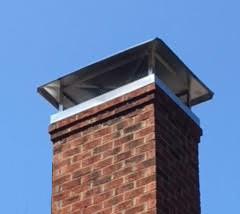Keep in mind that homeowner’s insurance covers SUDDEN events. In the case of your chimney, homeowner’s insurance does generally cover damages caused by events like these:
- Chimney Fires / House Fires
- Flash Floods
- Wind (such as a tornado or hurricane)
- Earthquakes
- Lightning Strikes
However, homeowner’s insurance generally DOES NOT cover damage resulting from poor maintenance. We’re most commonly asked if insurance will cover water leaks or water damage, and the answer is usually no.
Water damage can quickly multiply into expensive repairs, damaging adjacent framing, attic flooring, sheetrock walls, and paint finishes. It can cause expensive and dangerous mold buildup leading up to wood rot that can attract termites, ants, and rodents. Never delay addressing water issues involving your chimney!
The exterior of a brick chimney has several areas that are vulnerable to water damage, or areas where water damage can lead to further damage to your home.
Chimney Caps
Chimney caps are your chimney’s first line of defense against water penetration and damage. Besides keeping birds, squirrels, and other wildlife from entering your chimney, a chimney cap helps prevent rain from coming into the chimney. The most common type of chimney cap attaches to the flue tile liner of the chimney and has a roof lid that extends a few inches around it, and is referred to as a single flue chimney cap. However, while this cap will keep out birds, squirrels and various other varmints, it can sometimes make water problems worse. A better option would be a larger that covers the entire top of the chimney, with an overhanging lid that offers greater protection by covering the chimney’s mortar crown as well as the flue opening.
Mortar Crown
The mortar crown — or wash — is the bed of mortar at the top of your chimney. The mortar crown should be laid with a slope, as it helps shed rainwater away from your chimney. In this photo (compliments of RichmondChimneySweeps.com) it’s easy to see that the deteriorated mortar crown has allowed additional damage to the chimney. Note that the top row of bricks is missing mortar between them, thereby making those bricks unstable. While a chimney is built from the ground up, it deteriorates from the top down. Left unrepaired, these bricks would start falling off, perhaps onto the roof (causing further damage), into the chimney itself causing a blockage, or possibly onto people or cars below. The chimney’s mortar crown should be repaired or replaced long before it reaches this condition. Mortar crown repair is a service we provide, but it will not be covered by homeowner’s insurance.
Roof Flashing
Another area related to water damage on chimneys is the roof flashing, which is a metal installed where the roof adjoins the chimney to form a barrier to water entry. Improperly flashed roofing where it joins the chimney can allow water to leak into the attic and down the face wall of the chimney. Flashing problems are common; they are difficult to install properly and to seal correctly, making them susceptible to rusting out over the years. If you see water on the face wall of the chimney inside, above your fireplace opening, this generally indicates a problem with the flashing and can often be confirmed by a trip to the attic to inspect the underside of the roof adjacent to the chimney. Roof flashing repair is a maintenance issue and is .
Chimney Waterproofing
The exterior walls of your chimney are also vulnerable to water damage. Bricks are manufactured with a hard outer coating to help prevent water damage, but some bricks are made better than others and some bricks can begin to fail sooner than expected. If you see flaking bricks, called spalling, it’s past time to take action. Additionally, the mortar joints between the bricks can begin to deteriorate and need tuckpointing or if left unaddressed long enough the chimney may need to be rebuilt entirely. Waterproofing a brick chimney with a specially made clear coating will help prevent this type of water damage, and is a maintenance issue that should be addressed every 5-10 years.
Prefabricated metal chimneys and fireplaces are even more vulnerable to water damage than a masonry chimney is.
A prefabricated wood or gas burning fireplace is generally enclosed on the outside of your house with siding. They can be installed a number of ways but suffice it to say that most water damage related to a prefabricated fireplace is due to improper construction of the chase that surrounds it, it’s chase cover, or to improper installation of the fireplace or its venting system. In the case of a prefab fireplace, water damage can spread to adjacent walls and framing of your home. Additionally, water intrusion often leads to damaging the metal fireplace itself — thereby posing a fire threat as well.
Don’t neglect the care and maintenance of your prefabricated fireplace simply because you think it’s superior to a masonry fireplace. An important aspect of our service includes inspecting the visibly accessible areas of your fireplace installation and chase construction.
Please call Blue Sky Chimney Sweeps | Bless Your Hearth today to have your chimney and fireplace inspected, and we’ll carefully inspect for existing or potential water damage conditions.
